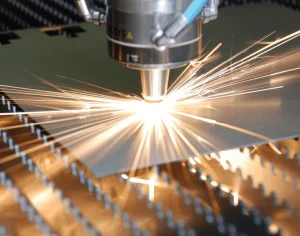Tech leaps are molding the medical field, and fiber laser welders stand out as a key player. These precise devices could transform medical welding by enhancing precision and speed in crafting devices and implants. This piece delves into fiber laser welders’ role in healthcare, spotlighting their potential gains and uses.
By grasping this tech’s power and limits, healthcare experts and industry players can lead the charge and maximize its benefits. This article aims to illuminate the impactful part exploring the future of fiber laser welders in the medical field play in advancing health care.
Key Takeaways
- Fiber laser welding technology has revolutionized the medical industry by enabling precise and efficient welding of medical devices.
- The use of fiber laser welders ensures precise and reliable joining of metal components, enhancing precision in welding delicate medical instruments.
- Fiber laser welding offers high precision and accuracy for intricate welds in medical devices, controls heat input to minimize thermal distortion and damage, and easily integrates with existing medical equipment.
- Implementing fiber laser welders in medical settings requires ensuring safety, compliance with standards, complex integration, and seamless integration with electronic medical records.
Advancements in Fiber Laser Welding Technology
The advancements in fiber laser welding technology have revolutionized the medical industry, allowing for precise and efficient welding of medical devices and equipment.
Fiber laser welding uses a high-intensity laser beam to melt and join metal components together. Compared to traditional welding methods, fiber laser welding offers numerous benefits.
Firstly, it provides greater control and accuracy, resulting in stronger and more reliable welds. This is especially crucial in the medical field, where the quality and integrity of welded devices can directly impact patient safety.
Additionally, fiber laser welding produces minimal heat-affected zones, reducing the risk of damage to delicate components or materials.
Furthermore, the speed and efficiency of fiber laser welding contribute to increased productivity and cost-effectiveness. As a result, medical manufacturers can produce high-quality devices at a faster rate, meeting the growing demands of the industry.
The Role of Fiber Laser Welders in Medical Procedures
Fiber laser welders play a crucial role in various medical procedures, ensuring precise and reliable joining of metal components. These advanced welding machines offer several benefits in the medical field, including:
- Enhanced precision: Fiber laser welders provide a high level of accuracy, allowing for precise welding of delicate medical instruments or components.
- Strong and durable welds: The use of fiber laser technology results in strong and durable welds, ensuring the longevity and reliability of medical devices.
- Non-contact welding: Unlike traditional welding techniques, fiber laser welders do not require direct contact with the materials being joined, minimizing the risk of contamination and damage.
These advantages make fiber laser welders an essential tool in medical procedures such as the assembly of surgical instruments, the fabrication of medical implants, and the repair of medical equipment.
With their ability to produce precise and reliable welds, fiber laser welders contribute to the advancement of medical technology and patient care.
Benefits of Fiber Laser Welding in the Medical Field
One of the key advantages of utilizing fiber laser welding in the medical field is its ability to ensure precise and reliable joining of metal components in various medical procedures. Fiber laser welding offers several benefits that make it an ideal choice for medical applications. Firstly, it provides high precision and accuracy, allowing for the creation of intricate and delicate welds in medical devices and implants. This is crucial for ensuring the safety and effectiveness of medical procedures. Additionally, fiber laser welding offers excellent control over heat input, resulting in minimal thermal distortion and damage to the surrounding tissues. Furthermore, fiber lasers have a small footprint and can be easily integrated into existing medical equipment, making them convenient and cost-effective. The table below summarizes the key benefits of fiber laser welding in the medical field.
Benefits of Fiber Laser Welding in the Medical Field
High precision and accuracy
Minimal thermal distortion
Easy integration with existing equipment
Cost-effective
Challenges and Solutions for Implementing Fiber Laser Welders in Medical Settings
Implementing fiber laser welders in medical settings presents a unique set of challenges and requires careful consideration of various factors. These challenges arise due to the sensitive nature of the medical field and the need for precision and accuracy in medical procedures.
Here are some key challenges that need to be addressed when implementing fiber laser welders in medical settings:
- Safety: Ensuring the safety of both patients and medical professionals is of utmost importance. Fiber laser welders should be designed and implemented in a way that minimizes the risk of injury or harm.
- Regulatory Compliance: The medical industry is heavily regulated, and any technology used in medical settings must comply with strict standards and regulations. Implementing fiber laser welders requires compliance with these regulations to ensure patient safety and legal compliance.
- Integration with Existing Systems: Integrating fiber laser welders into existing medical systems can be complex. Compatibility with other medical equipment and seamless integration with electronic medical records are crucial considerations.
Future Applications of Fiber Laser Welding in Medical Industry
The future of fiber laser welding in the medical industry holds immense potential for advancements in various applications. As technology continues to evolve, so does the use of fiber laser welding techniques in the medical field. From precision surgeries to medical device manufacturing, fiber laser welding offers several benefits such as superior weld quality, minimal thermal distortion, and enhanced precision.
To provide a glimpse of the future applications of fiber laser welding in the medical industry, the following table showcases some potential areas where this technology can be utilized:
Surgical Procedures: Fiber laser welding can be used for precise incisions, tissue sealing, and suturing, leading to reduced scarring and faster healing times.
Medical Device Manufacturing: Fiber laser welding can be employed in the production of medical devices such as pacemakers, prosthetics, and surgical instruments, ensuring high-quality and reliable products.
Dental Applications: Fiber laser welding can be utilized in dental procedures, including orthodontics, prosthetics, and dental implant surgeries, resulting in better precision and patient comfort.
Microsurgery: Fiber laser welding can enable intricate procedures such as microsurgery, allowing surgeons to work with extreme precision and accuracy.
Research and Development: Fiber laser welding can be used in research and development to explore new applications and advancements in the medical field, leading to innovative treatments and technologies.
With ongoing advancements in fiber laser welding technology, the possibilities for its future applications in the medical industry are vast. From improving surgical outcomes to enhancing medical device manufacturing, fiber laser welding is set to revolutionize the medical field, providing better patient care and treatment options.
Embracing the Potential of Fiber Laser Welding in Healthcare
Fiber laser welding has increasingly become a frequently utilized technology in the healthcare industry, showcasing its potential for revolutionizing medical applications. With its precision and versatility, fiber laser welding has opened up new possibilities in healthcare, offering numerous benefits for both medical professionals and patients.
Here are some key aspects of embracing the potential of fiber laser welding in healthcare:
- Enhanced precision: Fiber laser welding allows for precise and controlled welding of delicate medical devices and components, ensuring minimal damage and maximum accuracy.
- Improved efficiency: The speed and efficiency of fiber laser welding enable faster production and assembly of medical devices, reducing manufacturing time and costs.
- Minimized thermal damage: Fiber laser welding produces minimal heat-affected zones, preventing thermal damage to surrounding tissues and materials, making it ideal for applications in surgery and implantable devices.
Frequently Asked Questions
How Has Fiber Laser Welding Technology Advanced in Recent Years?
Fiber laser welding technology has advanced significantly in recent years. It offers higher precision, faster processing speeds, and improved weld quality. These advancements have made fiber laser welders more efficient and reliable, making them valuable tools in various industries, including the medical field.
What Specific Role Do Fiber Laser Welders Play in Medical Procedures?
Fiber laser welders play a specific role in medical procedures by providing precise and controlled welding capabilities. They are used in various applications such as medical device manufacturing, surgical tools, and implants, ensuring high-quality and durable connections in the medical field.
What Are the Benefits of Using Fiber Laser Welding in the Medical Field?
Fiber laser welding offers numerous benefits in the medical field, including precise and clean welds, minimal thermal damage to surrounding tissues, and the ability to weld various materials. These advantages make it an ideal choice for medical procedures requiring precision and accuracy.
What Challenges Are Faced When Implementing Fiber Laser Welders in Medical Settings, and How Are They Overcome?
When implementing fiber laser welders in medical settings, challenges may arise, such as the need for precision and safety. These challenges are overcome through rigorous quality control measures, extensive training, and adherence to strict regulations and guidelines.
What Are Some Potential Future Applications of Fiber Laser Welding in the Medical Industry?
Potential future applications of fiber laser welding in the medical industry include precision surgeries, the fabrication of medical devices, and the development of advanced medical implants. These applications can benefit from the high precision and minimal invasiveness of fiber laser welding technology.
Conclusion
In conclusion, fiber laser welders have the potential to revolutionize the field of medical welding by offering increased accuracy and efficiency in the creation of medical devices and implants. They bring numerous benefits such as improved patient outcomes and cost-effective solutions.
However, implementing fiber laser welders in medical settings may present challenges that need to be addressed.
Looking ahead, the future applications of this technology in the medical industry hold great promise for enhancing healthcare practices and outcomes.
You May Also Like:


